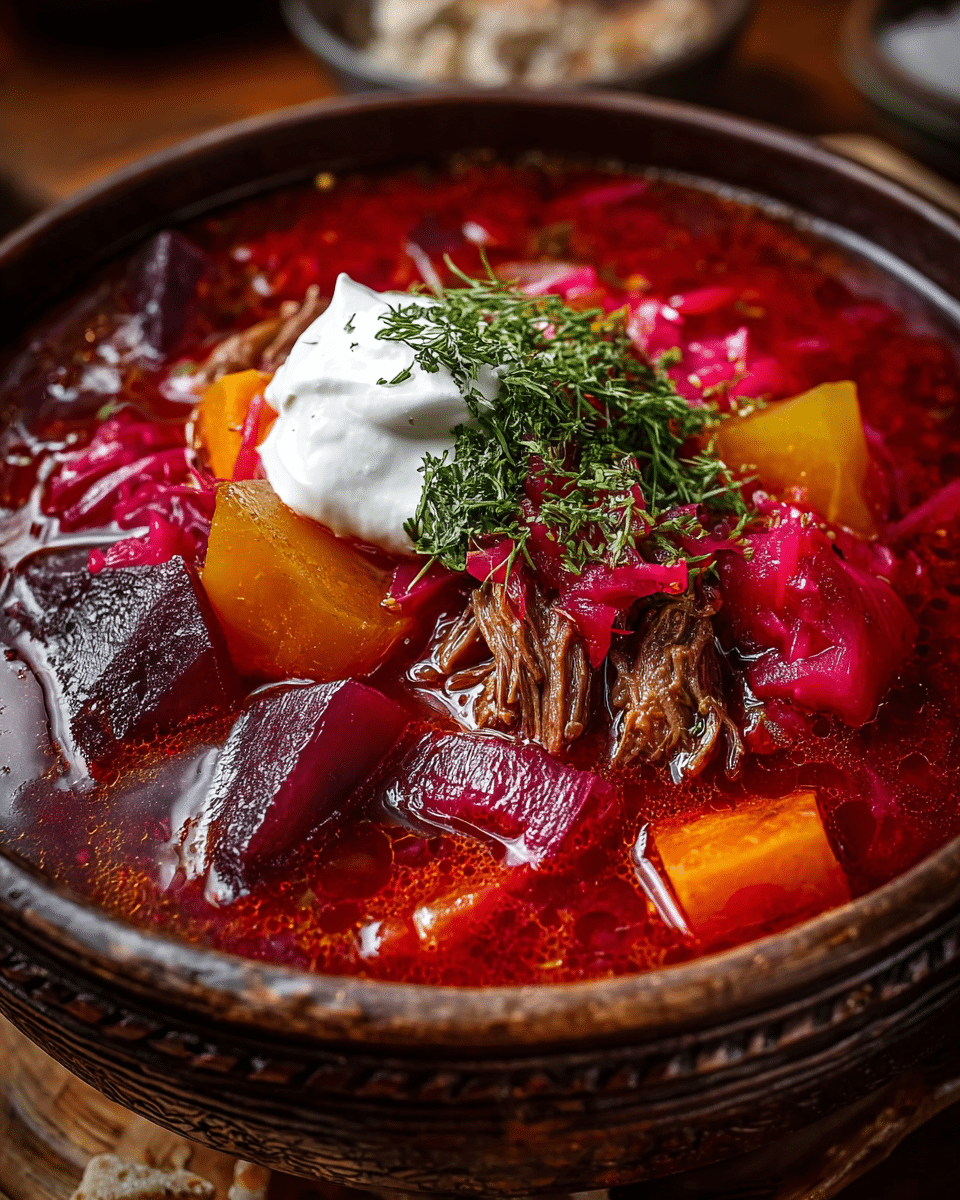This Ukrainian Beet & Beef Borscht presents a deep ruby-red broth crowning tender chunks of beef, potatoes, cabbage, and carrots, adorned with a swirl of creamy sour cream and bright flecks of fresh dill. The contrast of rich broth and aromatic garnish creates a visually stunning bowl that invites you to savor every spoonful. Every spoonful of this borscht embraces you with layers of flavor—the earthiness of beets, the umami depth of beef broth, the gentle sweetness of sautéed vegetables, and the tangy brightness from tomato paste and vinegar. Paired with the creamy tang of sour cream and the herbaceous sparkle of dill, it’s a bowl that warms both body and soul.
Full recipe:
Ingredients:
-
450 g beef shank with bone or 2 beef soup bones
-
2 liters water
-
1 bay leaf
-
3 medium beets, peeled and grated
-
1 large onion, finely chopped
-
2 carrots, peeled and grated
-
3 medium potatoes, peeled and cubed
-
1 small cabbage, shredded
-
3 cloves garlic, minced
-
3 tablespoons sunflower oil or vegetable oil
-
2 tablespoons tomato paste
-
1 tablespoon white vinegar
-
1 teaspoon sugar
-
Salt and pepper, to taste
-
2 tablespoons fresh dill, chopped
-
Sour cream, for serving
Directions:
-
In a large pot, combine beef shank or soup bones with 2 liters of water and 1 bay leaf. Bring to a boil, then reduce heat to low and simmer for 1.5 to 2 hours, skimming off any foam that rises. Once cooked, remove the meat, set aside to cool, and reserve the flavorful broth.
-
While the broth simmers, heat sunflower oil in a large skillet over medium heat. Add grated beets, white vinegar, and sugar. Sauté for about 5 minutes until beets soften. Then stir in tomato paste and cook for an additional 2 minutes. Transfer this vibrant mixture into the reserved broth.
-
In the same skillet, sauté chopped onion and grated carrots for 5 to 7 minutes until softened and fragrant. Add these to the simmering broth.
-
Add cubed potatoes and bay leaf to the pot. Simmer for about 10 minutes.
-
Stir in shredded cabbage and continue to cook until both cabbage and potatoes are tender—approximately 15 minutes.
-
Shred the cooled beef, discarding bones, and return the meat to the pot.
-
Add minced garlic, salt, and pepper to taste. Stir gently to combine all flavors.
-
Remove from heat, stir in fresh dill, and ladle the borscht into bowls. Serve hot with a generous dollop of sour cream.
Prep Time: 20 minutes | Cooking Time: 2 hours | Total Time: 2 hours 20 minutes | Kcal: approx. 250 kcal per bowl | Servings: 6 servings
The Heart of Ukrainian Cuisine: Borscht
Few dishes capture the spirit of a nation’s culinary tradition as powerfully as borscht does for Ukraine. This hearty beet-based soup is more than just food; it’s a symbol of comfort, resilience, and cultural pride. Passed down from generation to generation, borscht is found in almost every Ukrainian household, often made slightly differently depending on the region or family tradition. With its deep ruby-red color, rich broth, and balance of sweet, sour, and savory flavors, borscht is not only visually striking but also profoundly nourishing.
For many Ukrainians, a pot of borscht simmering on the stove evokes feelings of home and togetherness. It is often served during family gatherings, holidays, and festive occasions, bringing people to the table to share not just a meal, but a piece of cultural heritage. Beyond Ukraine, borscht has made its way into kitchens around the world, celebrated for its unique flavor and versatility.
A Brief History of Borscht
The origins of borscht date back centuries and are rooted in Eastern Europe. While variations exist in Poland, Russia, Lithuania, and other neighboring countries, Ukrainians proudly claim borscht as a national dish. Historically, it was prepared using ingredients that were readily available to peasants: beets, cabbage, potatoes, and other root vegetables. Over time, as trade expanded and resources grew, meat such as beef or pork was often added to enrich the flavor and provide sustenance during harsh winters.
Borscht became more than sustenance—it became an emblem of hospitality. Ukrainian households often prepared large pots of the soup to welcome guests, and recipes were adapted to suit religious fasts or festive celebrations. Today, authentic Ukrainian borscht continues to honor those traditions, retaining the essence of humble, nourishing ingredients while celebrating the artistry of slow cooking.
Why This Recipe Stands Out
Among the many versions of borscht, the authentic Ukrainian recipe stands out for its depth of flavor and balance of ingredients. The broth is made by simmering beef bones or shank, which creates a hearty base that is both rich and comforting. Fresh beets give the soup its signature color and subtle sweetness, while vinegar and tomato paste add a gentle tang that keeps the flavors lively.
Another reason this recipe is special lies in its layering of vegetables. The beets are sautéed separately with vinegar and sugar to preserve their vibrant color and enhance their natural sweetness. Carrots and onions add aroma, while cabbage and potatoes provide heartiness. The addition of garlic and fresh dill at the end brightens the soup, ensuring it feels fresh even though it’s robust and filling. A final dollop of sour cream ties everything together with a creamy tang, making each spoonful perfectly balanced.
The Health Benefits of Borscht
Beyond its taste, borscht is also celebrated for its health benefits. Beets, the star ingredient, are rich in antioxidants, particularly betalains, which give them their deep color and are known for anti-inflammatory properties. Beets are also a great source of folate, potassium, and fiber, which support heart health, digestion, and energy levels.
The soup’s abundance of vegetables makes it a nutrient powerhouse. Cabbage provides vitamin C and K, carrots contribute beta-carotene for healthy skin and eyes, and potatoes add potassium and complex carbohydrates for sustained energy. When prepared with beef bones, the broth also contains collagen and minerals that support joint and bone health.
Because it is loaded with vegetables yet relatively low in calories, borscht is also an excellent dish for those looking to eat healthier without sacrificing satisfaction. The sour cream topping can be adjusted to taste, or substituted with yogurt for a lighter option, making the dish adaptable to different dietary needs.
Cultural Significance of Borscht
Borscht is not just a meal—it is a cultural icon. In Ukraine, it symbolizes hospitality, family, and tradition. It is often served with rye bread, pampushky (garlic bread rolls), or dumplings, making it a complete meal in itself. For many Ukrainians abroad, cooking borscht is a way of staying connected to their roots and sharing their heritage with others.
The dish also plays a role in seasonal celebrations. During Christmas Eve, for example, a meatless version of borscht is often prepared as part of the traditional twelve-dish meal. Meanwhile, in colder months, hearty meat-based borscht provides warmth and nourishment. Its versatility and adaptability reflect the resilience of the Ukrainian people, who have preserved this recipe through centuries of change and hardship.
The Role of Ingredients
Each ingredient in borscht serves a unique purpose. Beets provide the foundation, both in flavor and appearance. Potatoes lend body to the soup, while cabbage brings texture and a gentle crunch. Carrots and onions build aromatic layers, while tomato paste and vinegar add acidity to balance the natural sweetness of the vegetables. Garlic and dill, added at the end, provide freshness and brightness, preventing the soup from feeling too heavy.
The use of beef bones or shank elevates the dish, creating a rich broth that forms the backbone of authentic Ukrainian borscht. While vegetarian versions exist, the depth of flavor in a meat-based broth is unmatched, making this recipe particularly hearty and satisfying.
Perfect Occasions to Serve Borscht
Borscht is incredibly versatile, making it suitable for a wide range of occasions. It can be served as a starter at formal dinners, a main dish for family meals, or as a comforting bowl on cold evenings. Because it is economical to prepare and yields large portions, it is also ideal for gatherings. A pot of borscht can easily feed a crowd, and leftovers often taste even better the next day as the flavors meld together.
Holiday feasts, casual get-togethers, or quiet weeknights—borscht adapts to them all. Pair it with crusty bread, sour cream, and perhaps a side of pickles, and you have a meal that is both simple and extraordinary.
Tips for Making the Best Borscht
The secret to great borscht lies in patience and balance. Allowing the broth to simmer for a couple of hours extracts maximum flavor from the beef bones. When sautéing the beets, adding vinegar not only preserves their vivid color but also gives the soup its characteristic tang. Using fresh dill instead of dried ensures a brighter flavor, while adding garlic at the very end intensifies its aroma.
Another tip is to let the borscht rest before serving. Many Ukrainians believe that borscht tastes best the day after it is cooked, when the flavors have had time to fully develop. Preparing it ahead of time can actually enhance the experience, making it a wonderful make-ahead dish for gatherings.
Variations and Adaptations
While the authentic version remains beloved, there are countless variations of borscht. Vegetarian borscht substitutes the beef broth with vegetable stock, often adding beans for protein. In some regions, pork or chicken replaces beef, creating slightly different flavor profiles. Seasonal vegetables, such as zucchini or peppers, may be added in the summer months, while mushrooms can be included in autumn.
Dairy-free adaptations replace sour cream with plant-based alternatives, while health-conscious cooks may reduce the amount of oil or sugar used. The adaptability of borscht is one of its greatest strengths—it can be tailored to dietary preferences without losing its essence.
Why Families Love This Dish
Families love borscht because it’s more than food—it’s a ritual. Cooking borscht together often involves multiple generations, with grandparents teaching grandchildren the proper way to sauté beets or season the broth. The process itself becomes an act of bonding, and the result is a meal that everyone can share.
The affordability of ingredients also makes it a practical choice for families. Despite its rich taste, borscht is made with humble vegetables and inexpensive cuts of meat, proving that delicious food doesn’t have to be extravagant. Its ability to feed many people at once makes it even more appealing for large families.
Conclusion
Authentic Ukrainian Borscht Soup is more than a recipe—it is a symbol of tradition, health, and togetherness. With its rich broth, vibrant beets, and layers of hearty vegetables, it nourishes both body and soul. Every spoonful tells a story of resilience, history, and hospitality, connecting generations through a shared culinary heritage. Whether you are cooking it to honor your Ukrainian roots, to explore a new cuisine, or simply to enjoy a warm and hearty meal, borscht is a dish that never disappoints. It is vibrant, flavorful, and deeply satisfying—proving why it has remained a beloved staple for centuries. Once you experience the richness of this authentic recipe, you will understand why borscht is celebrated not only in Ukraine but around the world.






